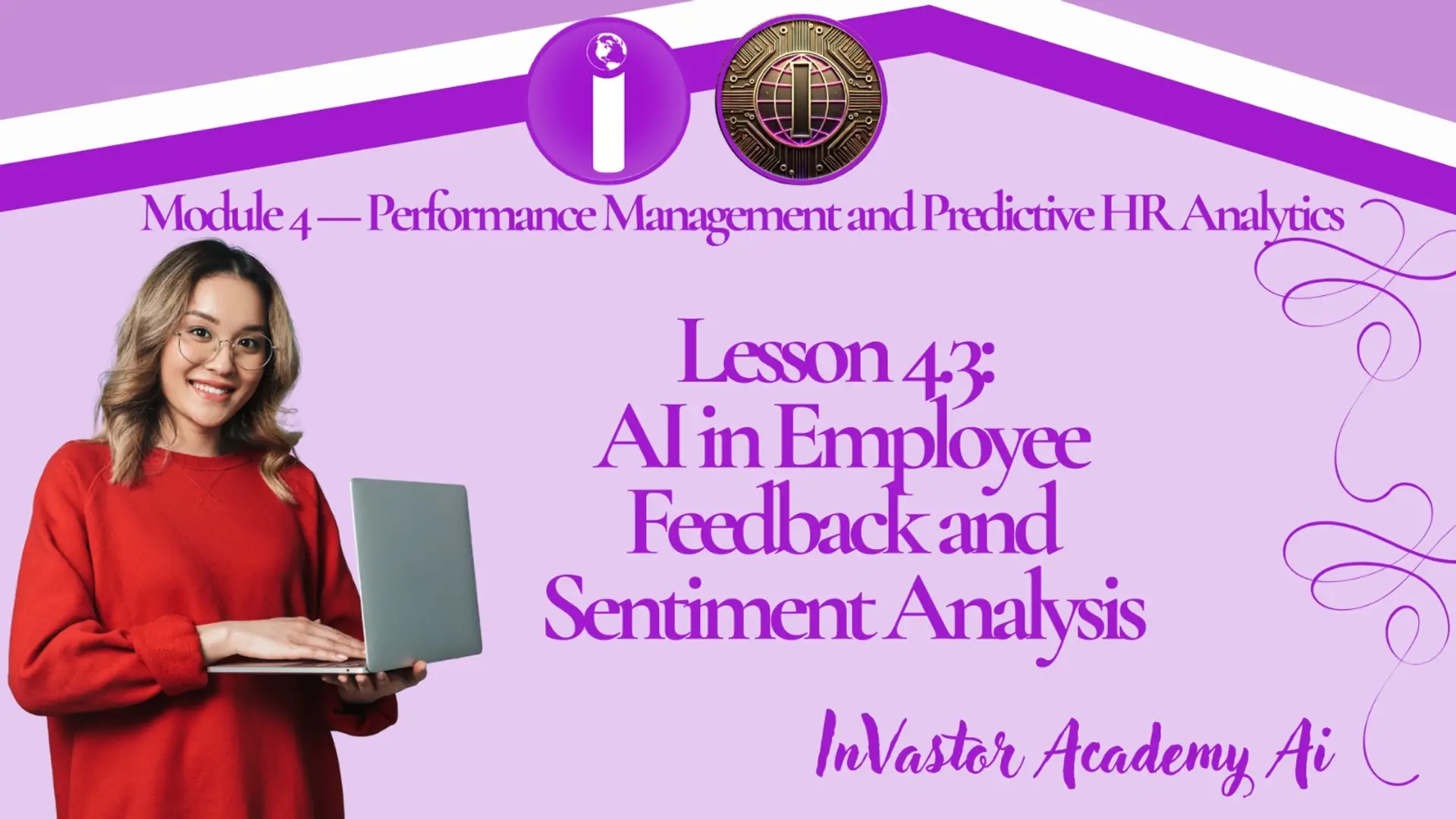

Lesson 4.3 — Using AI to Identify and Develop High-Potential Employees
Module 4 — Performance Management and Predictive HR Analytics
Lesson 4.3 — Using AI to Identify and Develop High-Potential Employees
Learning Objectives
By the end of this lesson, learners will be able to:
- Define what constitutes a high-potential (HiPo) employee in modern organizations.
- Explain how AI and analytics can identify leadership and growth potential.
- Describe AI tools used for high-potential identification and development.
- Assess ethical and fairness concerns in AI-based talent decisions.
- Apply best practices for combining AI insights with human evaluation.
1️⃣ Introduction: The Search for Tomorrow’s Leaders
High-potential employees (HiPos) represent the future leadership and innovation core of every organization.
Traditionally, identifying these individuals depended on manager intuition or performance reviews, which can be biased or inconsistent.
Today, AI and predictive analytics are transforming HiPo identification by analyzing performance, behavior, learning patterns, and engagement data to pinpoint employees with the highest potential for growth.
Example:
Deloitte uses AI-powered analytics to identify emerging leaders by analyzing performance reviews, feedback networks, and project outcomes — creating more inclusive and data-driven succession pipelines.
2️⃣ What Defines a High-Potential Employee (HiPo)?
A HiPo employee typically demonstrates:
- Consistent high performance
- Strong leadership capability
- Learning agility and adaptability
- Emotional intelligence and collaboration
- Future readiness — the ability to take on broader or more complex roles
- However, performance alone does not equal potential — AI helps distinguish between high performance (what someone achieves now) and high potential (what someone can achieve next).
3️⃣ How AI Identifies High-Potential Employees
AI uses a combination of data analysis, pattern recognition, and predictive modeling to evaluate potential.
Key AI-Driven Methods:
AI Function Description Example Tool
Predictive Analytics Forecasts employee growth trajectories Workday Talent Analytics
Natural Language Processing (NLP) Analyzes written feedback and reviews for leadership indicators Textio, KeenCorp
Behavioral Analytics Examines teamwork, collaboration, and initiative metrics Microsoft Viva Insights
Learning and Skill Data Mining Tracks learning engagement and skill acquisition trends Degreed, Cornerstone AI
360° Data Integration Combines performance, feedback, and peer data for holistic evaluation Eightfold.ai, Oracle HCM Cloud
Example:
A multinational firm used Eightfold.ai to detect hidden leadership potential among technical employees by analyzing project outcomes, peer feedback, and learning engagement — resulting in a 25% increase in internal promotions.
4️⃣ AI in Developing High-Potential Employees
Identifying HiPos is only the beginning — AI also helps develop them effectively.
Key AI Applications in HiPo Development:
✅ Personalized Learning Recommendations
AI platforms recommend tailored courses, mentorships, and stretch assignments aligned with an employee’s growth path.
✅ Adaptive Coaching
AI-driven platforms like BetterUp and CoachHub deliver digital coaching insights that adapt to the employee’s leadership style and progress.
✅ Skill Gap Analysis
AI identifies the competencies HiPos need to develop and suggests relevant learning resources.
✅ Career Path Prediction
Predictive models visualize possible career trajectories, helping HR guide HiPos toward optimal development paths.
Example:
Unilever uses AI to track the leadership readiness of its HiPo talent pool, recommending targeted learning modules and rotations based on career progression data.
5️⃣ Benefits of AI in HiPo Identification and Development
🌟 Data-Driven Accuracy: Reduces subjectivity in identifying potential.
🌟 Increased Diversity: AI helps uncover potential among underrepresented groups.
🌟 Personalized Growth: Tailors learning and career paths to individual strengths.
🌟 Proactive Succession Planning: Builds leadership pipelines based on predictive data.
🌟 Continuous Improvement: Monitors progress and development effectiveness in real time.
Example:
PepsiCo’s AI-based talent analytics revealed emerging HiPos from nontraditional backgrounds, supporting its diversity and inclusion goals.
6️⃣ Ethical Considerations and Risks
⚠️ Data Bias: AI models may replicate historical patterns that exclude diverse talent.
⚠️ Transparency: Employees should understand how “potential” is scored.
⚠️ Over-Reliance on AI: Human intuition, mentorship, and observation remain essential.
⚠️ Privacy Concerns: Protecting sensitive performance and behavioral data is crucial.
⚠️ Employee Trust: AI-based evaluation must be communicated clearly to build confidence.
Example:
If an AI system only uses past promotion data as a predictor, it may favor profiles similar to current leaders, reinforcing bias instead of eliminating it.
7️⃣ Best Practices for Responsible HiPo Identification
✅ Use diverse and balanced data to minimize bias.
✅ Combine AI analysis with human review and coaching insights.
✅ Maintain transparency about how potential is measured.
✅ Regularly audit algorithms for fairness and accuracy.
✅ Emphasize development support, not just talent classification.
💡 AI should empower employees to grow — not label them permanently.
8️⃣ Practical Activity
Task:
Create an AI-powered High-Potential Development Plan for your organization.
Include:
- The data you will analyze (e.g., performance, learning engagement, feedback).
- AI tools or analytics platforms you’ll use.
- Methods for ensuring fairness, diversity, and privacy.
- Development programs or learning paths you’ll recommend.
9️⃣ Supplementary Resources
- 🎥 “Identifying Future Leaders with AI” — Harvard Business Review
- 🎥 “AI and the Science of Potential” — Deloitte Human Capital Trends
- 🎥 “Personalized Leadership Development Using AI” — BetterUp Research
- 🎥 “AI Tools for Talent and Succession Planning” — SHRM Foundation
Lesson Quiz 4.3
Please complete this quiz to check your understanding of the lesson. You must score at least 70% to pass this lesson quiz. This quiz counts toward your final certification progress.
Answer the quiz using the Google Form below.
Click here for Quiz 4.3
Conclusion
AI has revolutionized how organizations recognize and nurture leadership potential — enabling fairer, faster, and more data-informed talent decisions.
Yet, true leadership development still requires human empathy, mentorship, and organizational culture to guide AI-driven insights.
💡 “AI can identify potential — but only people can unlock it.”
📘 Next Lesson: Lesson 4.4 — AI in Continuous Feedback and Real-Time Performance Coaching
📘 Previous Lesson: Lesson 4.2 — Predictive Analytics for Employee Performance and Retention
📘 Course Outline: Module 4 — Performance Management and Predictive HR Analytics
Related Posts
© 2025 Invastor. All Rights Reserved

User Comments